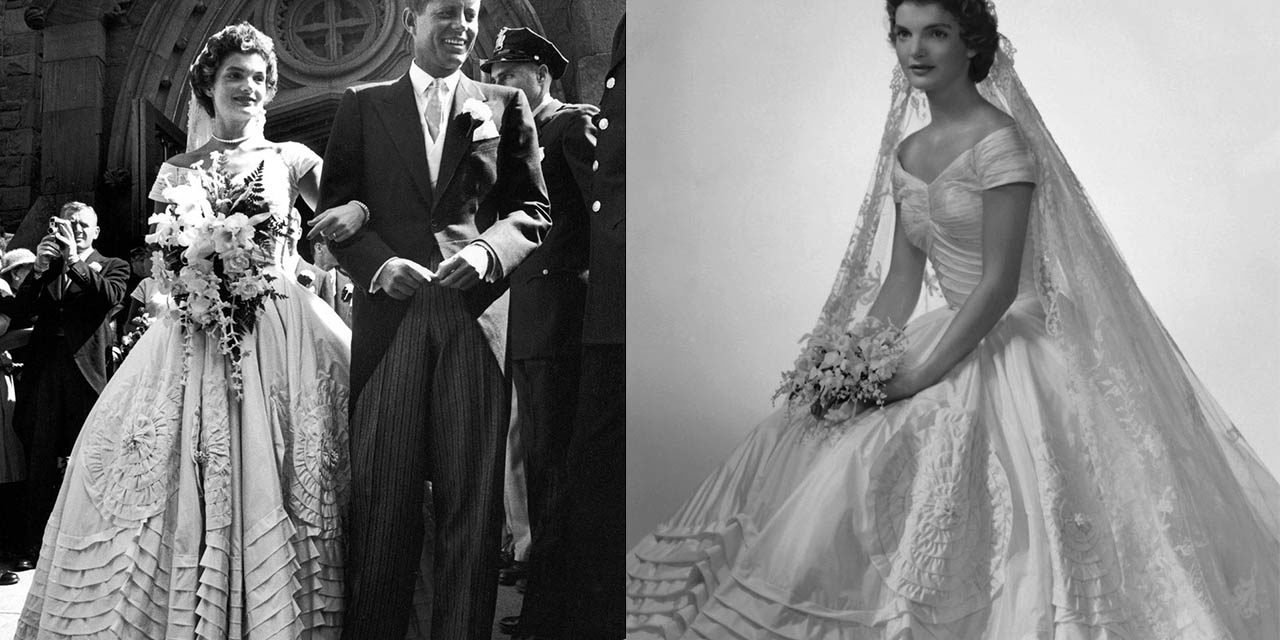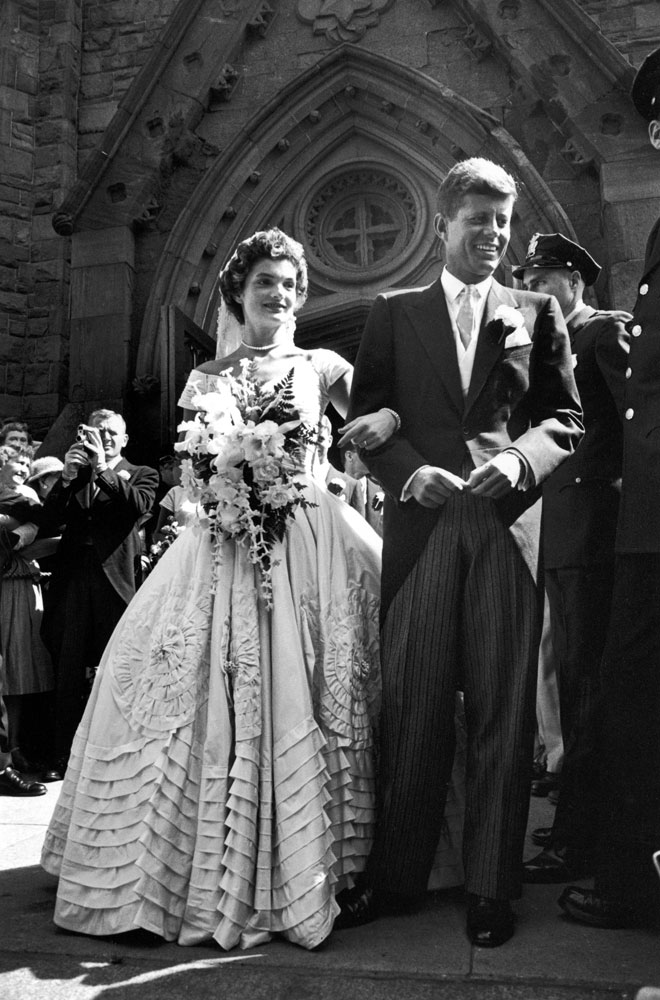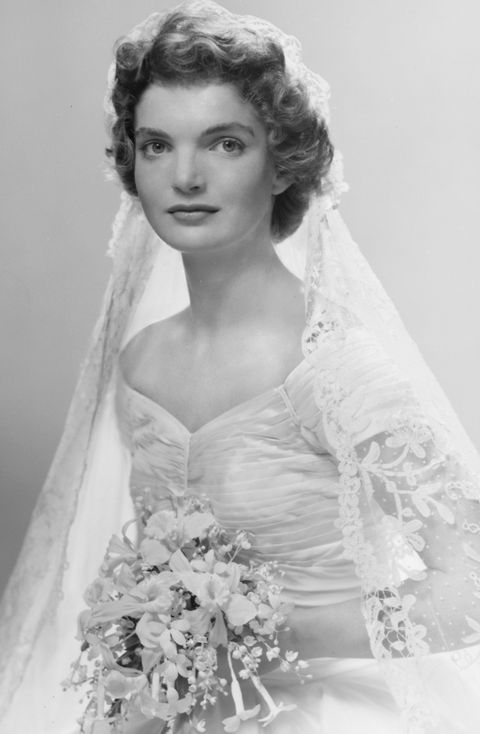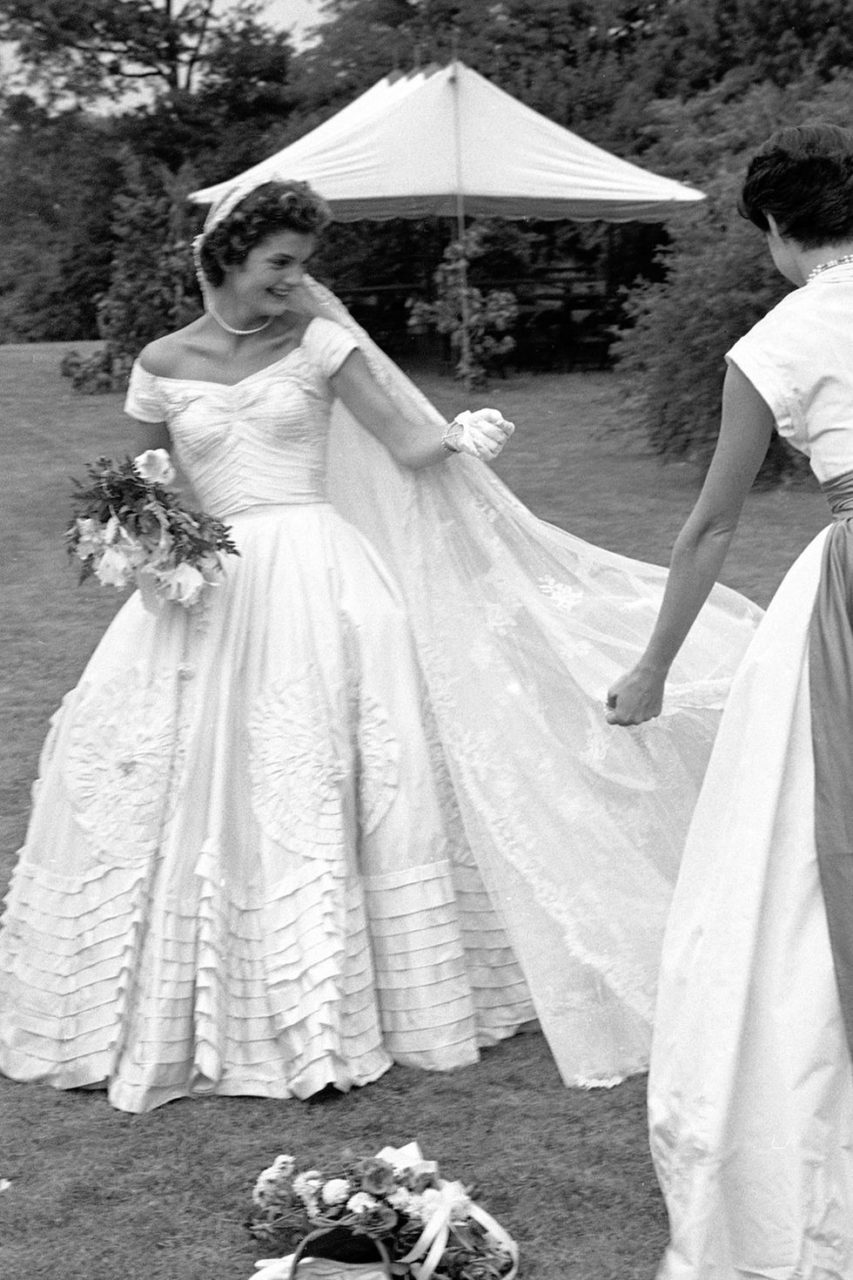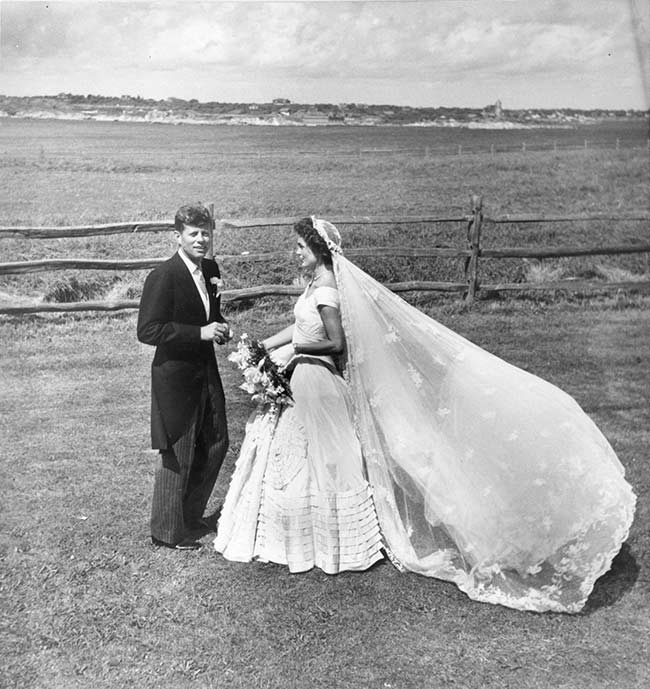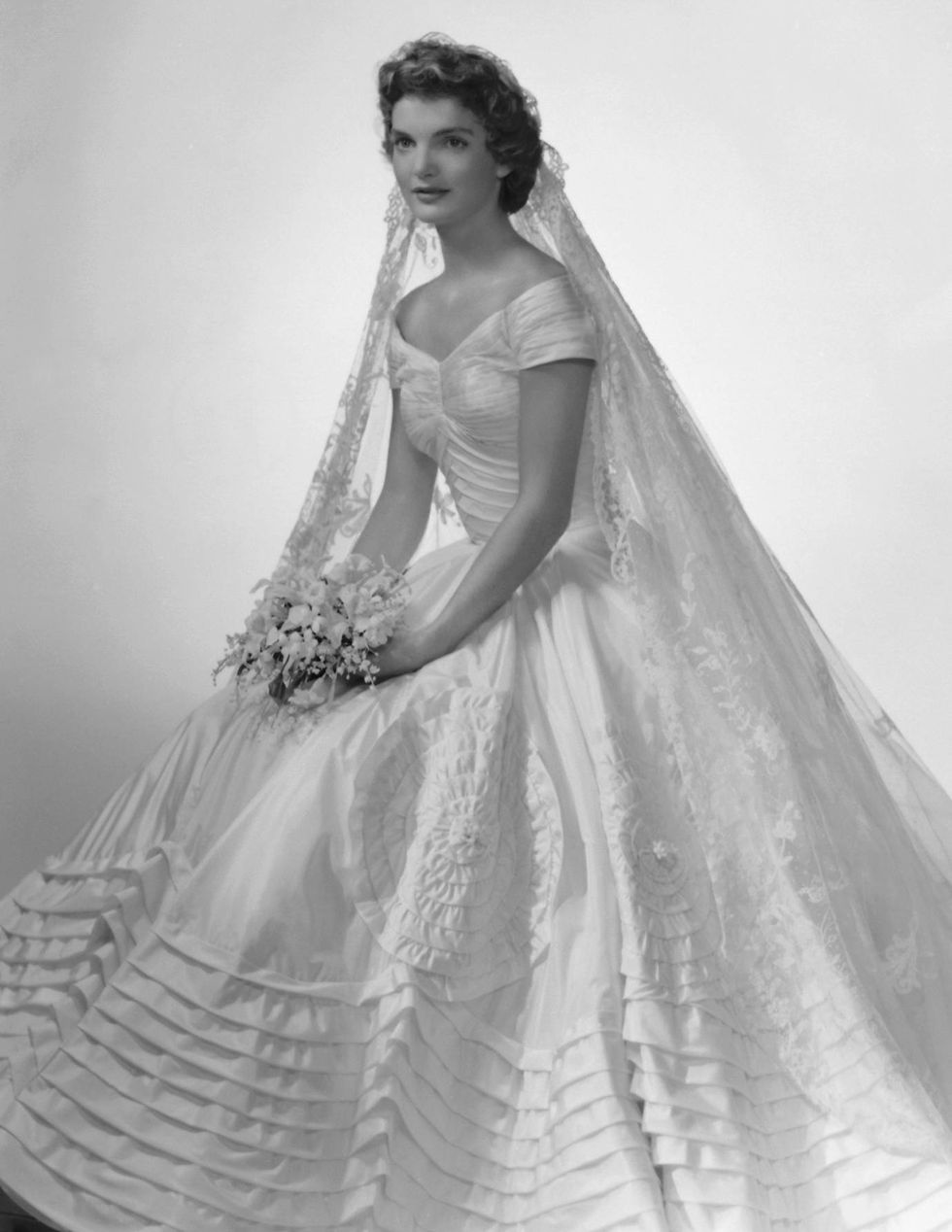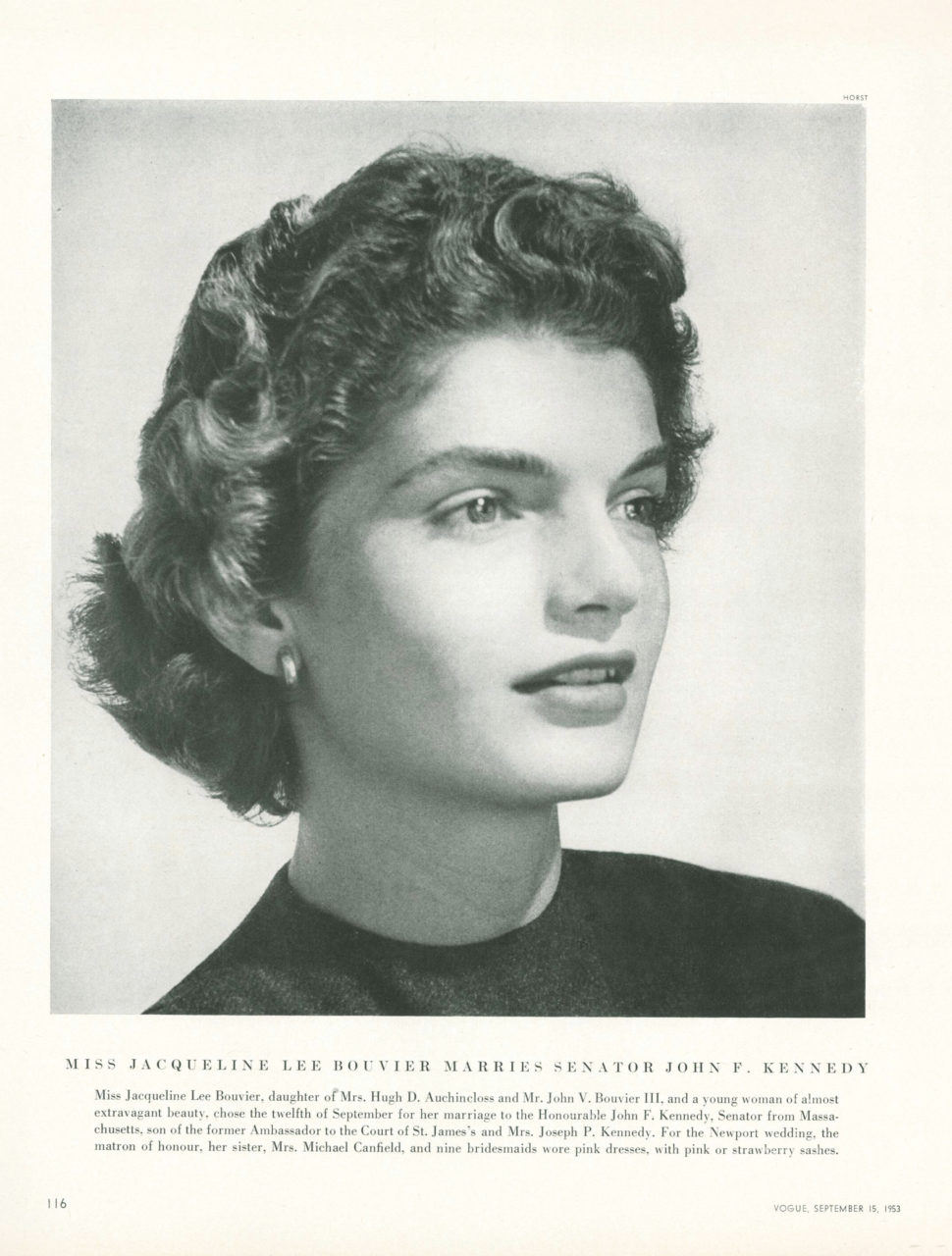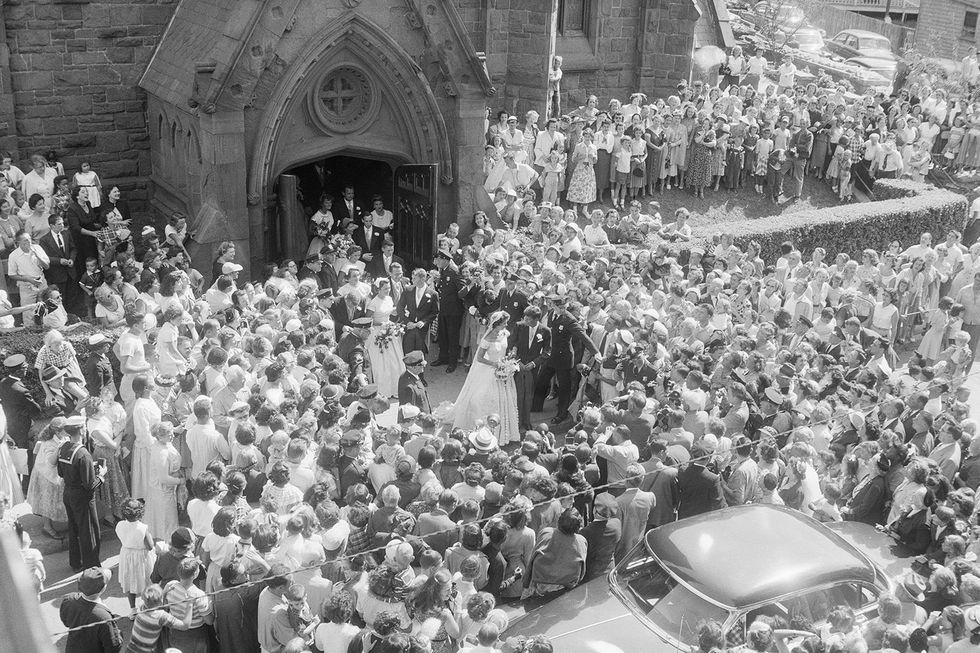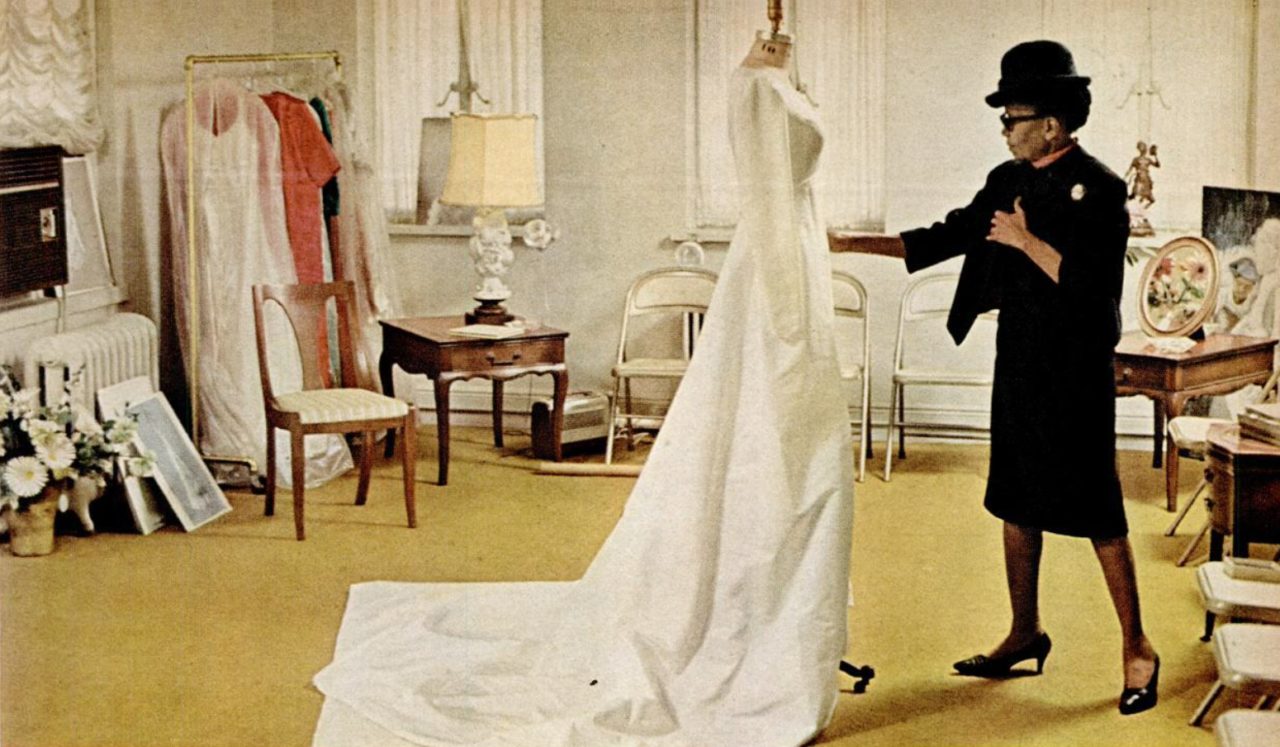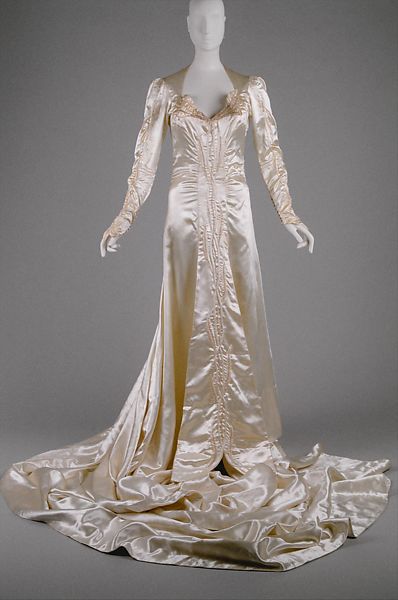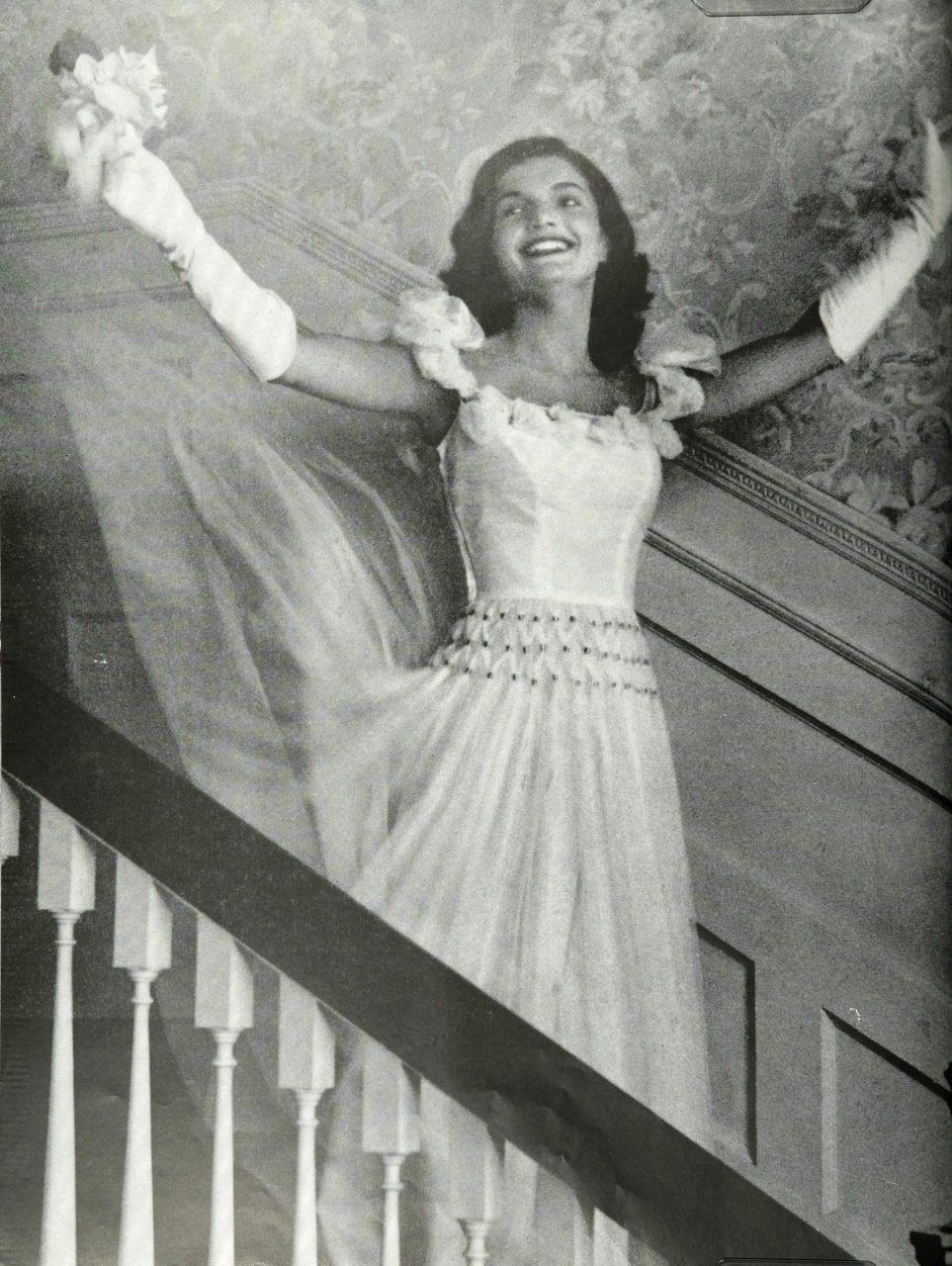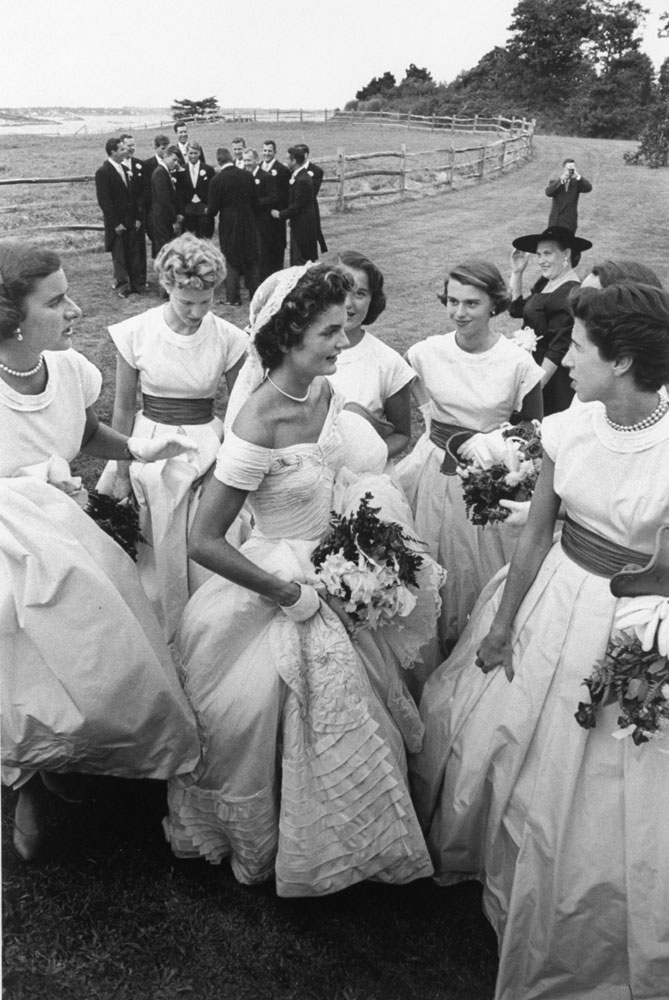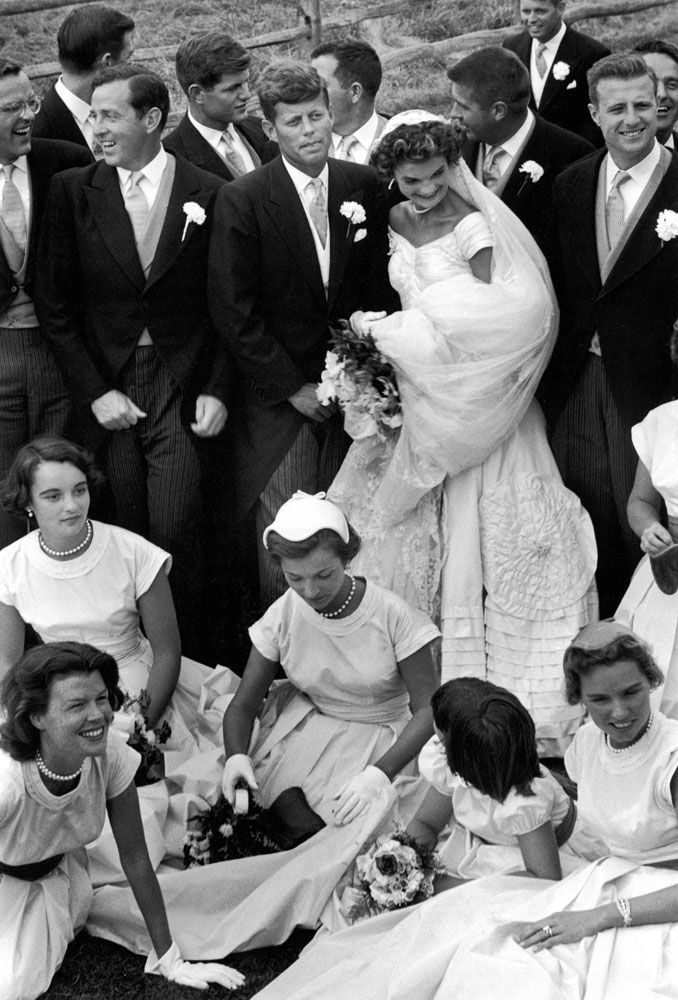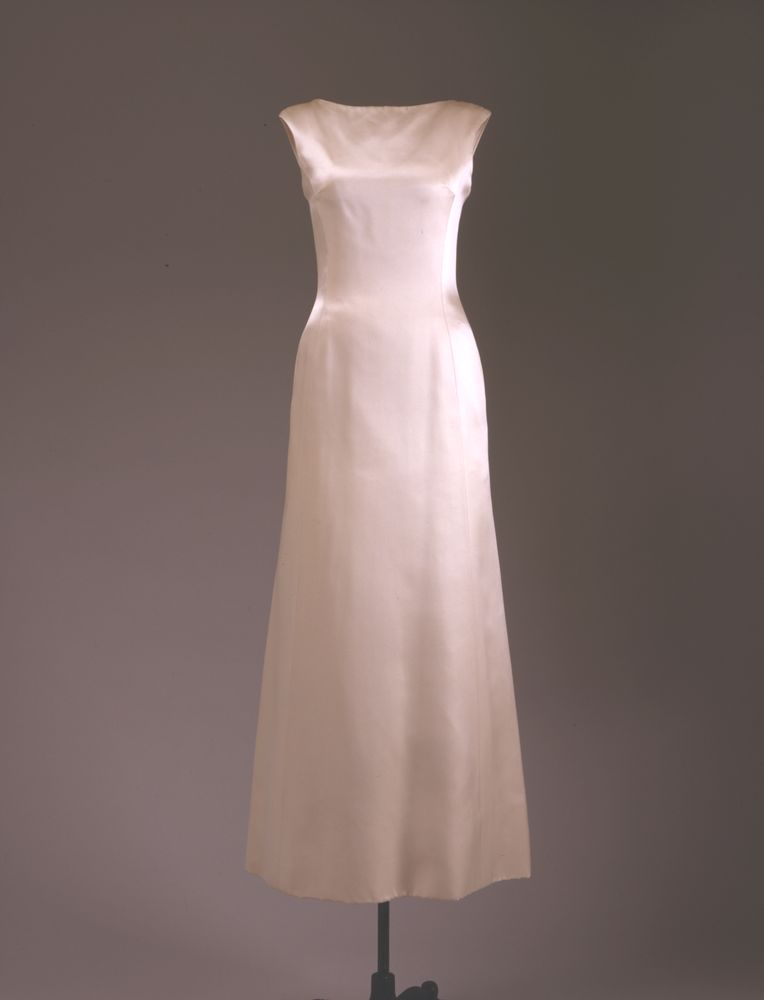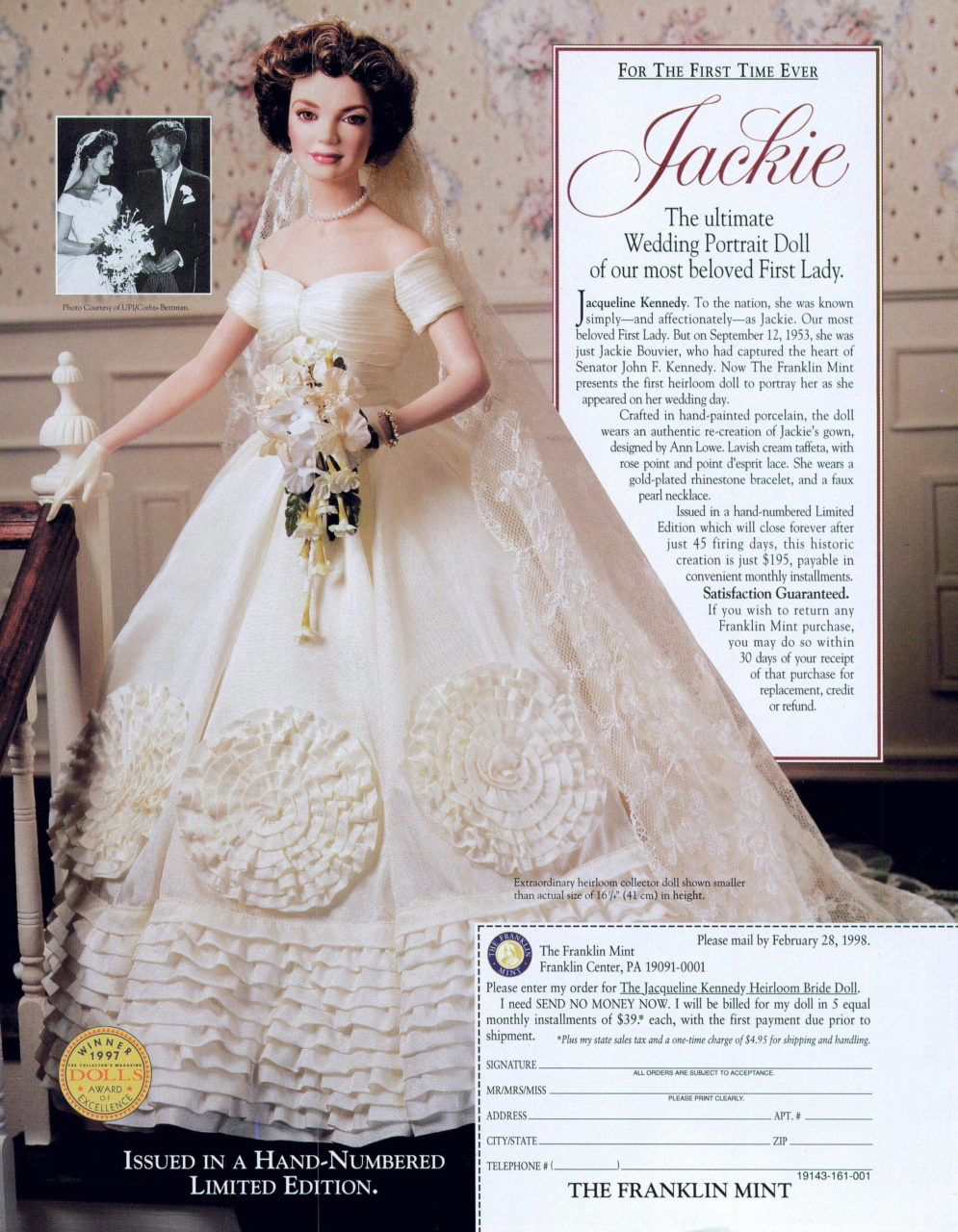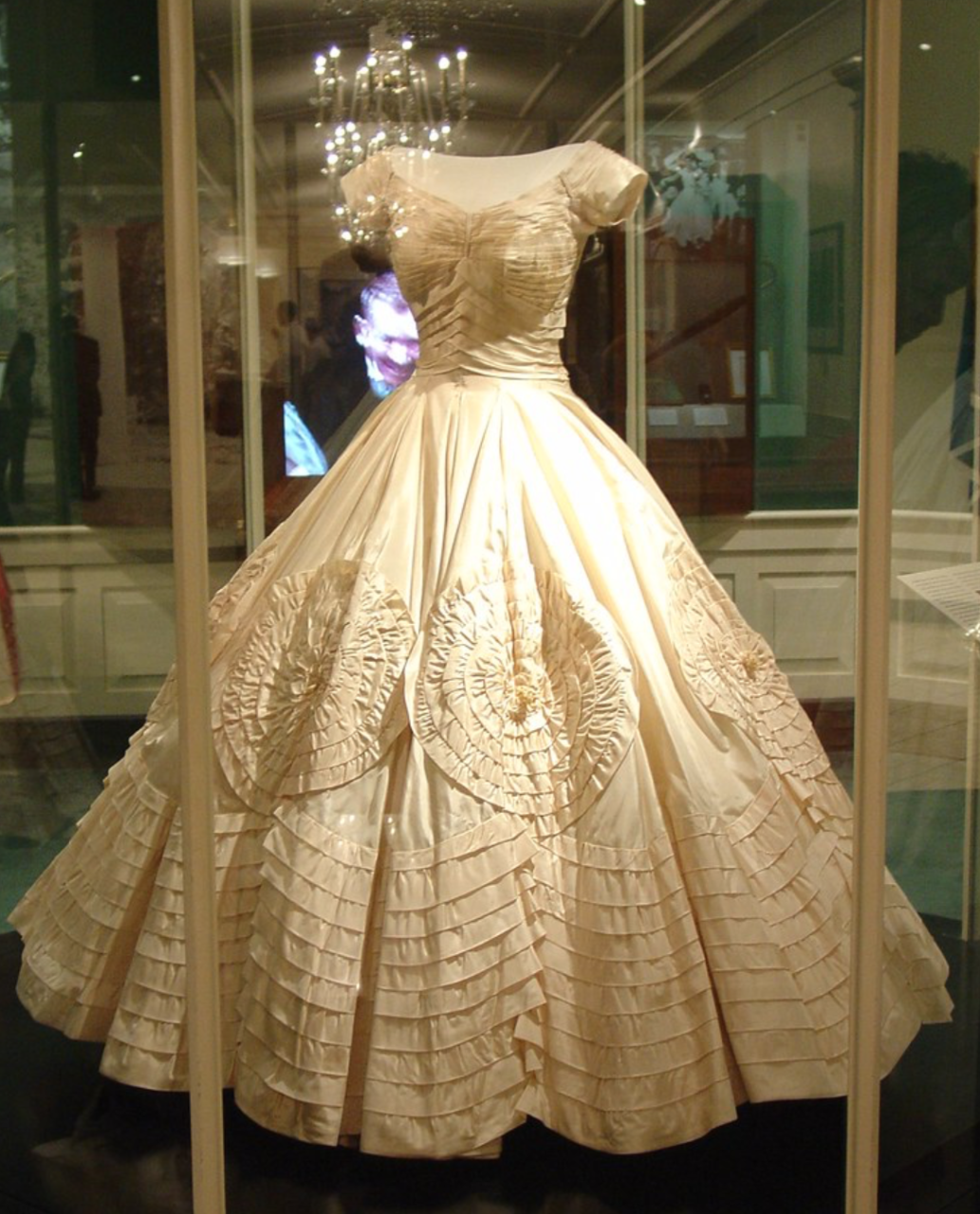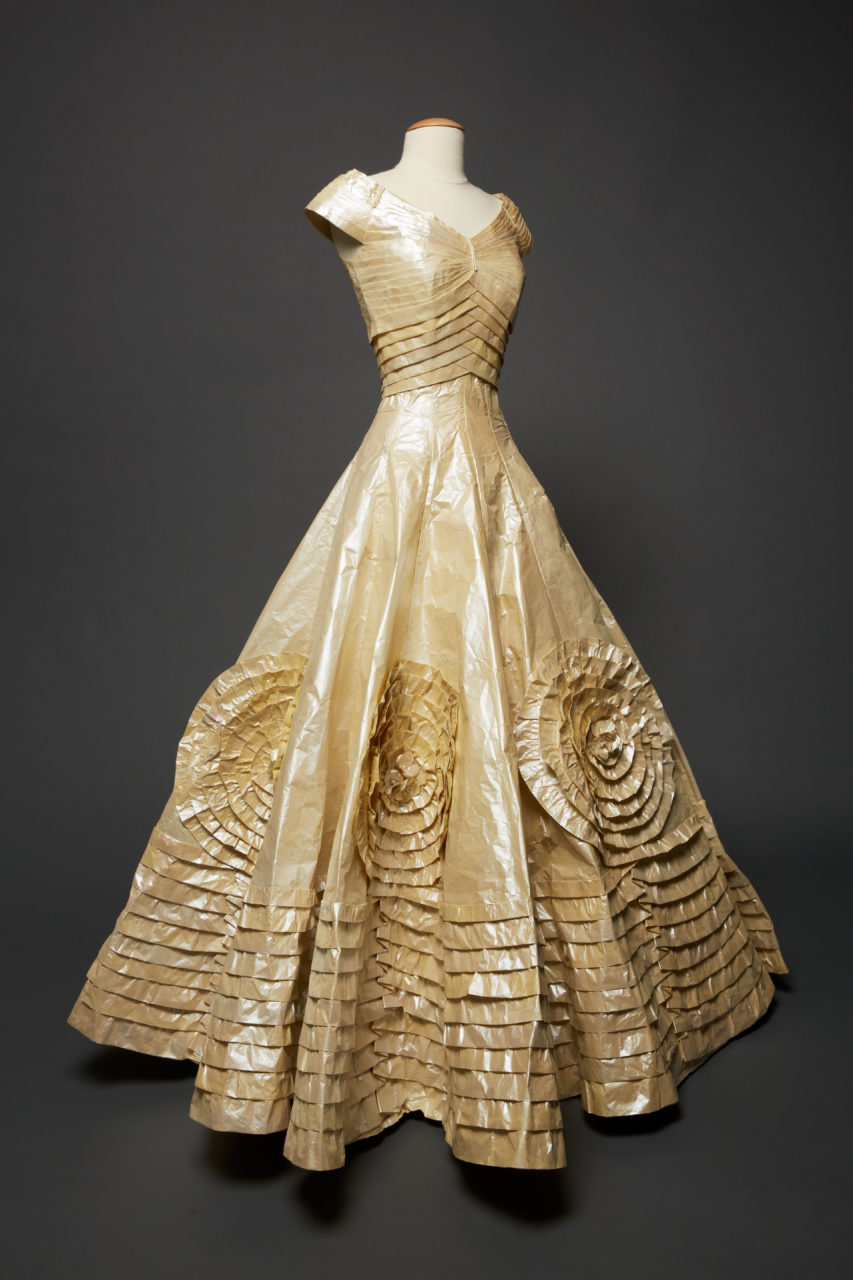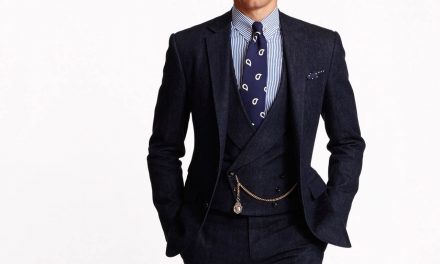About the Look
On the day Jacqueline Lee Bouvier married John F. Kennedy in 1953, she wore a custom gown by Ann Lowe (Fig. 1). Some have called it the “most photographed wedding dress in history” (Carter).
The dress, made with fifty yards of ivory silk taffeta, had the dramatic “New Look” silhouette fashionable of the early 1950s. Its fitted bodice featured a portrait neckline, and was embellished with interwoven bands of tucked fabric (Fig. 2) (Phelps). The skirt has been described as a “full bouffant” (Minutaglio). It also featured a sewing technique called “trapunto,” giving a layered, dimensional effect through ruffles and concentric circles (Fig. 3) (Davis & Grabowski).
In her book, Everything Jacqueline Kennedy Onassis Book: A Portrait of an American Icon, Kathleen Tracy described the rest of Jacqueline’s bridal ensemble, including her billowing lace veil (Figs. 4-5):
“Jackie wore her grandmother’s lace veil, which was attached to her hair with a small lace tiara decorated with traditional orange blossoms. Her jewelry was minimal: a single strand of family pearls, a diamond leaf pin (a wedding gift from Jack’s parents), and a diamond bracelet Jack gave her the night before the wedding. Her wedding bouquet was white and pink spray orchids and gardenias.” (95)
Although the wedding took place years before the couple entered the White House, Jacqueline’s wedding dress is not only considered one of her most iconic looks, but “one of the most iconic wedding-day looks of all time” (Minutaglio).
Fig. 1 - Lisa Larsen (American b. Germany, 1925-1959). Kennedy Wedding, 1953. The LIFE Picture Collection, 254161. Source: Getty Images
Fig. 2 - Bachrach. Wedding Portrait Of Jacqueline Bouvier, 1953. T1519086_48. Source: Getty Images
Fig. 3 - Lisa Larsen (American b. Germany, 1925-1959). Kennedy Wedding, 1953. The LIFE Picture Collection, 951730. Source: Getty Images
Fig. 4 - Lisa Larsen (American b. Germany, 1925-1959). Kennedy Wedding, 1953. The LIFE Picture Collection, 15904952. Source: Getty Images
Fig. 5 - Toni Frissell (American, 1907-1988). Kennedy Wedding, 1953. Washington D.C.: Library of Congress, LC-USZC4-4892. Source: Wikimedia Commons
Ann Lowe (American, 1898-1981). Jacqueline Kennedy’s Wedding Dress, 1953. Silk taffeta. Source: Getty Images
About the context
This American Dream of a wedding dress tells three distinct narratives: the political ambitions of the Kennedys, their conflict with Jacqueline’s personal desires, and unsung career of African-American designer Ann Lowe.
The story of John F. Kennedy’s political career is rooted in that of his father, Joseph Kennedy. Joseph was the son of a Boston politician, and grew to be a ruthless businessman and self-made millionaire (“Kennedy, John F.” 862). In exchange for large donations to the presidential campaign of Franklin D. Roosevelt, Joseph was given several government positions (“Kennedy, John F.” 862). However, as an anti-Semite and nazi-sympathizer he fell out of Roosevelt’s favor, ending his personal career in politics (Renehan).
Joseph Kennedy was determined to make one of his sons the first Catholic president of the United States (Beauchamp). He groomed his eldest son, Joseph Jr., for the job, but Joseph Jr. tragically died in 1944 while serving in World War II (“Son of J.P. Kennedy Killed in Action”). That left the second Kennedy son, John (nicknamed “Jack”), to bear the “burden” of his father’s dream (Beauchamp).
Following his military service and the end of World War II, the plan was set into motion. John F. Kennedy was elected to U.S. Congress in 1946, and after serving three terms as a congressman, he won a U.S. Senate seat in 1952 (Fig. 6). In 1960, he would become the youngest man ever elected President of the United States. However, as a newly-elected senator, Jack was still lacking something necessary for a future President: a wife and children. That changed on September 12, 1953, when he married Jacqueline Lee Bouvier (Fig. 7).
Fig. 6 - Kennedy Campaign. Brochure from Kennedy's 1952 Senatorial Campaign, 1952. Paper. Boston: John F. Kennedy Library and Museum, JFKPOF-135-003-p0002. Source: John F. Kennedy Library and Museum
Fig. 7 - Horst (German American, 1906-1999). Miss Jacqueline Lee Bouvier Marries Senator John F. Kennedy, September 15, 1953. Source: Vogue
Fig. 8 - Cosmopolitan. The Senator Women Elected, December 1953. Source: Cosmopolitan
Fig. 9 - Bettman. Kennedy Wedding, 1953. U1233251INP. Source: Getty Images
The nature of the young couple’s romance was described in a 1953 issue of Cosmopolitan:
“Jacqueline Lee Bouvier, the young lady who succeeded where so many had failed, is a charming brunette of tender years (twenty-four) and impeccable pedigree. They first met socially, in May, 1951, at the home of a distinguished Washington correspondent. Then Jacqueline, the inquiring photographer of the Washington Times-Herald, was sent in February, 1952, to get the then congressman’s views on some portentous subject. A romance swiftly flowered, though it was pursued with a remarkable lack of publicity — possibly not to undercut Kennedy’s appeal to his female admirers. The wedding, Newport’s most spectacular in three decades, took place last September twelfth.” (Ross 84-85)
An accompanying photo caption (Fig. 8) read:
“Kennedy married Jacqueline this fall in one of the year’s most fashionable social events. Enthusiastic crowds nearly crushed the newlyweds.” (Ross 84)
Indeed, the wedding was a high-society spectacle (Fig. 9) orchestrated by Joseph Kennedy, all in the pursuit of Jack’s future presidential run. There were “600 diplomats, senators, [and] social figures” at the ceremony, “2,000 society fans” outside the church, and “900 guests at the reception” — not to mention all of the press (“The Senator Weds”). As such, every detail needed the approval of the groom’s father (Martin). Another driving force behind the wedding was Jacqueline’s mother, Janet Lee Auchincloss (formerly Bouvier), who chose Ann Lowe to create the dresses for the entire bridal party (Davis & Grabowski).
Fig. 10 - Photographer unknown. Ebony Magazine, Ann Lowe in her Madison Avenue salon (December 1966): 137. Source: Ebony
By the 1950s, custom gown designer Ann Lowe was the “best-kept secret” of her high-society clientele (Minutaglio).
Lowe came from humble beginnings. She was born in Clayton, Alabama, in 1898, the granddaughter of an enslaved African-American woman who was emancipated in 1860 (Minutaglio). A talent for sewing and design ran through Lowe’s veins, as both her mother and grandmother were accomplished dressmakers (Davis & Grabowski). The three women founded their own dress company in Montgomery and sewed for local elites (Minutaglio). In 1914, when her mother suddenly passed away, Lowe was tasked with completing her commissions — including a gown for the First Lady of Alabama (Minutaglio). Lowe was only sixteen years old at the time.
Lowe’s immense talent led her to dressmaking opportunities in Tampa, Florida, sewing for the wife and daughters of a wealthy business tycoon (Laneri). In 1917, she was granted a sabbatical from that position to enroll in a couture sewing course in New York City (Laneri). However, the administrators hadn’t realized that Lowe was African-American when they accepted her, and insisted that she be segregated from the other students (Brockell). After receiving her diploma, she returned to work in Florida for ten more years, and then permanently moved to New York at age twenty-eight (Minutaglio).
Her first jobs in New York City were for businesses, like Saks Fifth Avenue and Hattie Carnegie (Laneri). Olivia de Haviland wore an Ann Lowe gown to the 1946 Academy Awards, though the label bore the name of her employer, Sonia Rosenberg (Kirkham 128).
Lowe’s creations finally had her name on them again in 1950, when she opened her own shop on Madison Avenue (Fig. 10). Her couture-quality custom gowns (Fig. 11) and relatively affordable prices attracted high-profile clients, including Roosevelts, Vanderbilts, and Rockefellers (Kirkham 128).
By that time, Lowe had already been sewing for the Bouviers and Auchinclosses for several years. In fact, Lowe did Janet’s gown for her 1942 second wedding to Hugh Dudley Auchincloss Jr. (Delloye). Lowe continued to have a long working relationship with the family, dressing them for various occasions, including Jacqueline’s “debut” gown (Fig. 12) (Delloye).
With Joseph Kennedy’s oversight, Ann Lowe received a commission for fifteen dresses: Jacqueline’s wedding dress, Janet’s mother-of-the-bride dress, and twelve others in the bridal party (Figs. 13-14).
Unfortunately, the commission turned out to be a nightmare for Lowe.
Disaster stuck just ten days before the Kennedy wedding. A pipe burst in Lowe’s studio, covering ten of the fifteen dresses — including the bride’s — in water, rust, and grime (Delloye). Keeping the ordeal a secret from the Kennedys, Lowe and her employees had to re-create in ten days what originally took them eight weeks (Davis & Grabowski). Lowe also needed to purchase new materials and hire extra seamstresses, turning any profit into a huge financial loss (Delloye).
When the dresses were finally finished, Lowe decided to hand-deliver them from New York City to Newport, Rhode Island (Davis & Grabowski). The staff at the door insisted that she enter through the back, however, Ann refused. She threatened to take the dresses back with her if she were not allowed in through the front door (Davis & Grabowski).
Fig. 11 - Ann Lowe (American, 1898-1981). Wedding dress, 1941. Synthetic. New York: The Metropolitan Museum of Art, 1975.349a, b. Gift of Mrs. K. Fenton Trimingham Jr., 1975. Source: The Metropolitan Museum of Art
Fig. 12 - Robert Meservey (American, 1921-2013). Jacqueline Lee Bouvier as a debutante, March 1961. Source: Ladies' Home Journal
Fig. 13 - Lisa Larsen (American b. Germany, 1925-1959). Jacqueline and her bridal party, 1953. The LIFE Picture Collection, 245359. Source: Getty Images
Fig. 14 - Lisa Larsen (American b. Germany, 1925-1959). Jacqueline and Jack with their wedding party, 1953. The LIFE Picture Collection, 254153. Source: Getty Images
Fig. 15 - Oleg Cassini (American, b. France, 1913-2006). Ivory evening gown, 1962. Duchesse silk satin. Boston: John F. Kennedy Museum, MO 63.1332. Source: John F. Kennedy Museum
Fig. 16 - Oleg Cassini (American, b. France, 1913-2006). Ivory evening dress, 1961. Duchesse silk satin. Boston: John F. Kennedy Museum, MO 63.1335. Source: John F. Kennedy Museum
Despite overcoming those great obstacles, Lowe unfortunately did not receive proper credit for the dresses. When reporters asked Jacqueline who made her wedding dress, she explained she wanted something French, but instead “a colored dressmaker” did it (Martin). Only one reporter, Nina Hyde of the Washington Post, actually followed up to discover Ann Lowe’s name (Martin). All of the numerous other stories ran without any mention of her. Understandably, Lowe was very disappointed.
The truth was that through no fault of Lowe’s, the magnificent wedding dress was not Jacqueline’s taste. In fact, the same could likely be said of many elements of her wedding. Unlike Jack Kennedy and his father, Jacqueline was a “quiet, reserved woman” who “disliked the spotlight of public life” (“Kennedy, Jacqueline”). However, Jack’s father was the “architect” of their lives, and planned the ceremony as a propaganda event rather than something private or sacred (Mulvaney).
The wedding dress of Jacqueline’s dreams was not one of an American Dream, and thus, Joseph could not allow it (Martin). Jacqueline favored French designers and modern simplicity, which directly opposed Joseph’s desired statement of romanticism and post-war prosperity. Of course, Jacqueline capitulated. However, she felt the dress didn’t flatter her small frame and “thought it looked a little bit like a lampshade” (Mulvaney). Jacqueline’s simple, streamlined fashion sense would eventually become hallmarks of her iconic style in the White House (Figs. 15-16), when she favored American designer Oleg Cassini.
Nevertheless, the two women felt no animosity towards each other. In fact, many years later when Lowe was on the verge of losing her business, an anonymous benefactor intervened (Minutaglio). Julia Faye Smith, author of Ann Lowe’s biography Something to Prove, told ELLE:
“Ann always felt it was Mrs. Kennedy, and I like to think it was and that she did so because she had learned of the wedding dress disaster and Ann’s integrity in righting the situation.”
Its Afterlife
According to Caroline Kennedy, daughter of Jack and Jacqueline, they discovered her mother’s wedding dress “all crumpled up in a Lord and Taylor’s box in the warehouse” (Mulvaney). Since then, however, the John F. Kennedy Library and Museum in Boston has taken great efforts to preserve it. The dress was displayed in 2003 during a special temporary exhibit to honor the couple’s fiftieth wedding anniversary (Fig. 26). However, it has been deemed too fragile to be displayed again.
The John F. Kennedy Library and Museum is also in possession of an exact paper replica of the dress (Fig. 27). It was commissioned in 2004 by Marshall Field’s Department Store in Chicago, and created by Isabelle de Borchgrave and Rita Brown. The replica was displayed in 2013, in honor of the couple’s sixtieth wedding anniversary.
However, the paper dress is technically not the only replica in existence. In the late 1990s, The Franklin Mint sold “The Jacqueline Kennedy Heirloom Bride Doll,” which featured an exact miniature re-creation of her wedding gown by Ann Lowe. However, the doll’s original copy made no mention of her as its designer. Lowe’s children demanded recognition for their mother, who had passed away in 1981 (White). After letters, phone calls, and press attention, The Franklin Mint revised the advertisement to include the following (Fig 28):
“Crafted in hand-painted porcelain, the doll wears an authentic re-creation of Jackie’s gown, designed by Ann Lowe.”
Fig. 19 - The Franklin Mint. The Jacqueline Kennedy Heirloom Bride Doll, February 1998. Source: Town & Country
Fig. 17 - Ann Lowe (American, 1898-1981). Jacqueline Kennedy's wedding dress on display in 2003, 1953. Boston: John F. Kennedy Library and Museum. Source: Flickr
Fig. 18 - Isabelle de Borchgrave and Rita Brown. Paper Replica of Jacqueline Kennedy's Wedding dress, 2004. Boston: John F. Kennedy Library and Museum. Source: John F. Kennedy Library and Museum
References:
- Beauchamp, Cari. “Two Sons, One Destiny.” Vanity Fair, December 2004. https://www.vanityfair.com/news/2004/12/kennedy-200412.
- Brockell, Gillian. “Jackie Kennedy’s Fairy-Tale Wedding Was a Nightmare for Her African American Dress Designer.” The Washington Post. WP Company, August 28, 2019. https://www.washingtonpost.com/history/2019/08/28/jackie-kennedys-fairy-tale-wedding-was-nightmare-her-african-american-dress-designer/.
- Carter, Penny. “Lewis Chapter DAR Honors Late Fashion Designer.” The Eufaula Tribune, February 14, 2018. https://www.dothaneagle.com/eufaula_tribune/lewis-chapter-dar-honors-late-fashion-designer/article_66385548-11a5-11e8-abfe-e7b4585cc687.html.
- Davis, Nancy, and Amelia Grabowski. “Sewing for Joy: Ann Lowe.” National Museum of American History, August 29, 2019. https://americanhistory.si.edu/blog/lowe.
- Delloye, Tate. “How the granddaughter of a former slave escaped Jim Crow to design Jacqueline Kennedy’s iconic wedding dress and become ‘society’s best kept secret’ as the personal couturier for the Rothschilds, Roosevelts and Rockefellers.” Daily Mail Online. Associated Newspapers, March 8, 2020. https://www.dailymail.co.uk/news/article-8088979/Ann-Lowe-Jacqueline-Kennedys-wedding-gown-personal-couturier-American-aristocracy.html.
- “Kennedy, Jacqueline.” In Modern World Part II: 1946-2003, edited by Sara Pendergast and Tom Pendergast, 922-923. Vol. 5 of Fashion, Costume, and Culture: Clothing, Headwear, Body Decorations, and Footwear through the Ages. Detroit, MI: UXL, 2004. Gale eBooks (accessed June 10, 2020). https://libproxy.fitsuny.edu:2653/apps/doc/CX3425500602/GVRL?u=fitsuny&sid=GVRL&xid=687389c2.
- “Kennedy, John F.” In Biographies, edited by Sara Pendergast and Tom Pendergast, 110-117. Vol. 2 of The Sixties in America Reference Library. Detroit, MI: UXL, 2005. Gale eBooks (accessed June 8, 2020). https://libproxy.fitsuny.edu:2653/apps/doc/CX3441300049/GVRL?u=fitsuny&sid=GVRL&xid=be399531.
- “Kennedy, John F.” In Gale Contextual Encyclopedia of American Literature, 862-865. Vol. 2. Detroit, MI: Gale, 2009. Gale eBooks (accessed June 8, 2020). https://libproxy.fitsuny.edu:2653/apps/doc/CX3008100268/GVRL?u=fitsuny&sid=GVRL&xid=b427d047.
- Kirkham, Pat. Women Designers in the USA, 1900-2000: Diversity and Difference. New Haven: Yale University Press, 2000. http://www.worldcat.org/oclc/48628173.
- Laneri, Raquel. “Why Jackie Kennedy’s Wedding Dress Designer Was Fashion’s ‘Best Kept Secret’.” New York Post, October 16, 2016. https://nypost.com/2016/10/16/jackies-wedding-dress-designer-is-finally-recognized/.
- Martin, Micheal. “Wisdom Watch: Author Chronicles History of Black Designers.” NPR, September 12, 2007. https://www.npr.org/transcripts/14343918?storyId=14343918?storyId.
- Minutaglio, Rose. “Ann Lowe Is the Little-Known Black Couturier Who Designed Jackie Kennedy’s Iconic Wedding Dress.” ELLE, October 24, 2019. https://www.elle.com/fashion/a29019843/jackie-kennedy-wedding-dress-designer-ann-lowe/.
- “Miss Jacqueline Lee Bouvier Marries Senator John F. Kennedy.” Vogue, Sep 15, 1953, 116, https://libproxy.fitsuny.edu:2818/docview/904334702?accountid=27253.
- Mulvaney, Jay. Kennedy Weddings: A Family Album. New York: St. Martins Press, 2002. http://www.worldcat.org/oclc/50147774.
- Phelps, Timothy M. “Ann Lowe, 82, Designed Gowns for Exclusive Clientele in Society: Five Designs in Museum.” New York Times (1923-Current File), Mar 01, 1981. https://libproxy.fitsuny.edu:2818/docview/121729041?accountid=27253.
- Renehan, Edward. “Joseph Kennedy and the Jews.” History News Network. George Washington University. Accessed June 8, 2020. https://historynewsnetwork.org/article/697.
- Ross, Irwin. “The Senator Women Elected.” Cosmopolitan, 12, 1953, 80-85, https://libproxy.fitsuny.edu:2818/docview/1999145782?accountid=27253.
- Son of J.P. Kennedy Killed in Action.” New York Times (1923-Current File), Aug 15, 1944. https://libproxy.fitsuny.edu:2818/docview/106834281?accountid=27253.
- “The Senator Weds.” LIFE, September 28, 1953, 45-46, 48. https://books.google.com/books?id=7UcEAAAAMBAJ&lpg=PP1&pg=PA45#v=onepage&q&f=false.
- Tracy, Kathleen. Everything Jacqueline Kennedy Onassis Book: a Portrait of an American Icon. Cincinnati: F W Media, 2010. http://www.worldcat.org/oclc/767500623.
- White, Renee Minus. “Anne Lowe: Creator of Jackie Kennedy’s Wedding Dress.” New York Amsterdam News, November 27, 1997. http://libproxy.fitsuny.edu:2055/login.aspx?direct=true&db=a2h&AN=9712170430&site=ehost-live.

